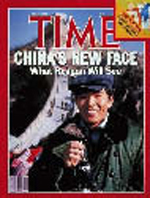|
"Bird's Nest Curls" and Bell-Bottomed Jeans
After decades of isolation, China began allowing Western films and cultural and entertainment products from Hong Kong and Taiwan to enter the mainland in 1978. The "Bird's Nest Curls" hairstyle and bell-bottomed jeans — symbols of spiritual independence, rebellion and freedom — found immediate favor with young people in defiance of orthodoxy despite criticism from conservatives.
The "Bird's Nest Curls" was a derogatory term for curled hair, since the most popular style at the time reminded older people of a bird's nest. To them the hairstyle was at best indecent, but the bell-bottomed jeans were considered absolutely obscene, since they exposed the female form in all its glory. Those who wore them were considered "hooligans," or at the very least "indecent." There were extreme cases when indignant conservatives would take scissors with them and cut jeans they saw on the street.
1979
The Arrival of Coca-Cola
 |
Time's interpretation of an opening China — a man in a Mao-style overcoat holding a bottle of Coca-Cola. |
Three hours after China and the United States declared the establishment of diplomatic relations in 1979, Coca-Cola announced its entry into China. Three weeks later, the first batch of Coca-Cola was shipped in from Hong Kong and put on the shelves of big markets and hotels in Beijing, Shanghai and Guangzhou.
Soon after, the company donated a production line to China. As a symbol of the American lifestyle, the arrival of Coca-Cola caused a big stir in China. The production line was given to Shanghai, but it met with strong resistance. Local newspapers published articles and letters that decried the introduction of the production line as a betrayal of the country, claiming the move relegated China to the status of a slave of a foreign master, promoted a capitalist lifestyle and dealt a blow to national industries.
As a matter of fact, Coca-Cola first arrived in Shanghai in the early 1920s. In 1948 the Shanghai factory became Coca-Cola's first overseas bottling facility to reach an annual output of one million cases. The American company withdrew from Shanghai before the People's Republic of China was founded in 1949. New China symbolized the end of the national humiliation that marked the century-long period of semi-colonialism when China lived under the coercion and hegemony of imperialist powers, including the United States. The Western policy of enmity toward the New China further exacerbated Chinese hostility, which continued through to the "cultural revolution" (1966-1976) and further to the early stages of the country's reforms.
| 